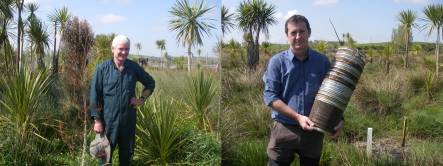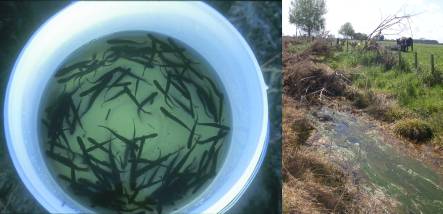Our Changing World for Thursday 18 November 2010
Black Mudfish and Restoring Lake Kaituna

Black mudfish (Neochannus diversus) (image: Waikato University)
Nick Ling, from the Department of Biological Sciences at the University of Waikato is an expert on New Zealand's mudfishes, a group of five species that are part of the wider Galaxiid group of freshwater fishes. New Zealand's mudfishes (PDF - note large file) are very unusual fish - when their wetland habitats dry out in summer they burrow into the soil and remain there, motionless, breathing air, until the first decent flood in autumn refills the wetland and washes them from their refuge. Early settlers in New Zealand were surprised to find live fish when digging vegetables from the earth. These cryptic, nocturnal fish were probably once the most abundant freshwater fish in New Zealand. However, the loss of more than 90% of our wetlands over the past two centuries has confined them to a few refuges, and three of them are endangered (PDF of recovery plan).

Farmer Andrew Hayes amongst regenerating natives (left), and biologist Nick Ling with Gee minnow traps for catching mudfish (images: A. Ballance)
Nick Ling takes Alison Ballance on a rural tour near Hamilton to look for a black mudfish, and to show her conservation efforts that are helping restore mudfish habitat. She meets Horsham Downs dairy farmer Andrew Hayes, and talks about his family's very successful Care Group Efforts on Lake Kaituna (also know as Lake B), a small peat lake on their farm. She also talks with student Rebecca Eivers about sediment traps, being used to prevent sediment run-off into the lake, and with former student Amy McDonald who carried out a successful black mudfish translocation to Lake Kaituna.

Lake Kaituna is a successful peat lake and wetland restoration, surrounded by a productive dairy farm (images: A. Ballance)
Andrew and Jenny Hayes, and their sons Alastair, Rodney, Derek and Fred were awarded a Ministry for the Environment Green Ribbon Award for Rural Sustainability in 2007 in recognition for their care, effort and leadership shown to improve the health of the peat lakes in the Horsham Downs area (PDF).

This roadside ditch near Hamilton is still home to black mudfish, but they no longer occur in the large numbers they once did (as evidenced by an earlier successful catch). (Images: Waikato University and A. Ballance)
Carbohydrates

Antony Fairbanks, a sugar, and Marie Squire at the mass spectrometer (images: A. Fairbanks)
Carbohydrates are well known for the important role they play in biological process, for example: storing energy and strengthening of cell walls. Over recent years though, it's become apparent that the sugars attached to the outside of cells are also essential for biological function. For example, it's estimated that well over two thirds of all mammalian proteins have sugars attached to them (ie they are glycosylated) adding an extra level of sophistication. These glycoproteins are potential therapeutics, but there are some hurdles to using them as medicines, firstly, they aren't homogeneous with respect to their carbohydrate portions, and secondly, they can't be purified to homogeneity.
The University of Canterbury'sAntony Fairbanks and his research team are synthesising carbohydrates, and particularly sugars, in the laboratory, and would like to access defined homogeneous glycoproteins. Ruth Beran meets him, and Marie Squire, who shows her one of the analytical tools the group uses to conduct their research: the Ultra High Resolution Time of Flight (UHR-TOF) tandem mass spectrometer.
Modelling the Human Breast

Angela Lee, a modelled image of the breast, and Martyn Nash
The most common cancer among New Zealand women is breast cancer, with more than 2500 new cases expected this year. While early detection of breast cancer can increase a woman's chance of survival, the techniques used to detect breast cancer, such as X-ray mammography, MRI and ultrasound, each have their limitations. For example, although mammography is the gold standard technique for detecting tumous, small tumours can be difficult to identify because of poor contrast and the large deformations of breast tissue during compression.
Using methods designed to study aircraft wings, a team of researchers at the University of Auckland's Bioengineering Institute are modelling the breast to track breast tissue motion. As Martyn Nash and Angela Lee explain to Ruth Beran, their work may one day help clinicians better locate breast tumours for biopsy and treatment.
To see a video of the researchers and a breast phantom, click here.